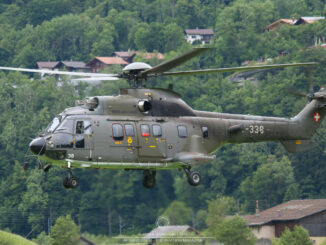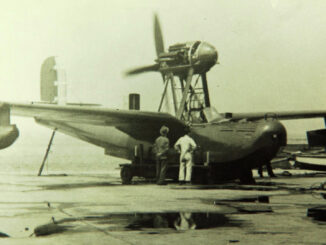
PZL 104 ‘Wilga 35A’, STOL utility aircraft (SP-EBK c/n 61123), Aero Club of Włocławek, April 2014.
At the turn of the 1950s and 1960s, the need for a modern, lightweight multipurpose aircraft to be used mostly for civil aviation purposes, began to grow in Poland. Such an aeroplane was intended for various tasks, including – among others, glider towing and parachute training at domestic flying clubs, as well as for use in crop-dusting and medical transport. Therefore, the desired aircraft was to be characterised by good performance, economy of use and had to have a short take-off and landing capability.
Work on preliminary project of an aircraft that would meet those demands and requirements started in 1959. A team of constructors from Aviation Constructions Centre of WSK Okęcie (Centrum Konstrukcji Lotniczych WSK Okęcie) aviation plant, led by engineer Ryszard Orłowski, was responsible for its development. The project was named PZL 104 ‘Wilga‘ (English: oriole) and was a high-wing, cantilever, all-metal monoplane with fixed landing gear with a tailwheel. The aircraft had to be powered by a 185 hp WN-6RB piston boxer engine, especially designed for this purpose by Wiktor Narkiewicz.
The first prototype of the aeroplane, officially designated as ‘Wilga 1′, was built in February 1961, being intended for static tests in the Department of Strength of the Aviation Institute (Departament Wytrzymałości Instytutu Lotnictwa). In June of the same year the aircraft – already registered as SP-PAZ, was officially displayed at the 30th International Fair in Poznań and then in September, at the Exhibition of the 15th Anniversary of Aviation Industry in Warsaw.
The ‘Wilga 1′ had an angular and spacious fuselage, wings and control surfaces yet covered with canvas, but static tests revealed poor aerodynamic characteristics of such solution. A stiffening was needed in the area of cabin roof and its junction with the rear part of the fuselage, and moreover, the aeroplane was 140 kilograms heavier than expected. Another problem was caused by excessive overheating of the prototype engine. All of this finally resulted in insufficient performance of the new aircraft.
In the summer of 1961, when the chief engineer of the project, Ryszard Orłowski, left WSK Okęcie aviation plant, works on the aircraft were taken over by Bronislaw Żurakowski. In the autumn of the same year, necessary structural changes dictated by the results of the above mentioned static tests were introduced to the design. Then, on 23rd December 1961, during taxi trials, the aircraft made its first few ‘jumps’. And a few months later, on 24th April 1962, after the engine finally passed its state tests, the PZL 104 ‘Wilga 1′ performed a maiden flight.
Since then, a set of test flights have begun which have resulted in redesigning of the fuselage. In the meantime, Indonesia showed some interest in the ‘Wilga’ aircraft, and therefore creating an additional incentive for increased work on further development of the PZL 104. And in fact, the chance of export sale of the ‘Wilga’ led to a decision concerning complete redesign of the aircraft.
A new preliminary design was developed yet in early 1962 by Andrzej Frydrychewicz. Shortly thereafter, a team of designers led by him and the aforementioned Bronisław Żurakowski focused on building a new version of the aircraft, designated PZL 104 ‘Wilga 2′.
This time, the aircraft received a completely new, stronger yet lighter monocoque fuselage with significantly improved visibility. In addition, housing and cowling of the engine have been redesigned, as well as landing gear and empennage. The wings were changed the least: only the fuel tanks were changed and completely new ailerons and flaps were designed, which in the new version of the aircraft – as well as elements of the fuselage and empennage – were covered with grooved sheet metal. The ‘Wilga 2′ had to be powered by a WN-6RB2 engine with 185 hp and to be 190 kilograms lighter than its predecessor.
On 1st August 1963, prototype of the PZL 104 ‘Wilga 2′ performed it first flight. This aircraft then became the actual prototype for subsequent development versions of the aeroplane.
However, continuous problems with cooling of the Polish WN-6 type engine resulted in its rejection as ‘Wilga’ powerplant. Then a Soviet-designed, nine-cylinder Ivchenko AI-14R radial engine of 260 hp, already being manufactured in Poland under licence by PZL-Kalisz, was selected as the new power unit. Its installation in the airframe was possible only after a few more changes, therefore creating another variant, called ‘Wilga 3’. It took-off for the maiden flight on 31st December 1965.
Analyses and conclusions from the use of ‘Wilga 3′ soon led to development of its modified version with a wider and more massive undercarriage, eventually designated as PZL 104 ‘Wilga 35′. The first example of this type was flown on 29th July 1967 (although some sources say that it took place a day earlier). In the beginning of 1968, the aeroplane eventually entered into serial production.
Although further versions of the PZL 104 were developed in subsequent years, it was just the ‘Wilga 35′, that was the most produced and most widely used version of this aeroplane. From the approximately 1000 aircraft produced, 935 were ‘Wilga 35′ and ‘Wilga 80′, the latter being a variant adapted to American regulations. Thus, the PZL 104 became the most numerous produced aircraft of Polish design.
The PZL 104 ‘Wilga 35′ became a true icon of Polish general aviation and, for many years, a real workhorse in domestic aero clubs. A modification designated as ‘Wilga 35A’, being capable of towing gliders, became the most popular one and even today can be seen in many Polish aero clubs, being used for this purpose.
In addition, between 1971 and 1993, a total of 27 ‘Wilga 35’ and ‘Wilga 35A’ aeroplanes were operated by the Polish military aviation as a liaison aircraft.
Sixteen PZL 104 ‘Wilga C’ (which was a variant of ‘Wilga 2’ but equipped with a Continental O-470 engine) were both produced in Poland for Indonesia or assembled there. The same was regarding ‘Wilga 32′, being a ‘Wilga 3’ with the above mentioned engine, with 6 of them manufactured in Poland and 18 at LIP Nurtanio aviation plant in Bandung, and designated as Gelatik.
Among other foreign operators of the ‘Wilga’ aircraft, there are several Eastern Bloc countries, as well as Austria, Belgium, Canada, Cuba, Egypt, France, Germany, Great Britain, Iceland, Mongolia, New Zealand, Spain, Switzerland, Turkey, USA, Yugoslavia and Venezuela. It was, and often still is, also widely used by DOSAAF organization in the Soviet Union (and now in Russia).
The last development variant of this aeroplane was called PZL 104 ‘Wilga 2000’, being characterized by improved aerodynamics and powered by a Lycoming IO-540 boxer engine. It was in serial production in several sub-versions between 1998 and 2008, with the last example being delivered for Icelandic operator. Several ‘Wilga 2000’ aircraft are still being operated by the Polish Border Guard.
A great potential of the PZL 104 aircraft, mainly of its latest version ‘Wilga 2000′, was noticed in the USA and Canada, where they are being modified for bush flying. And perhaps the most famous example of such ‘Wilgas’ is the one named ‘Draco’, being built by Mike Patey from Utah, USA.
The PZL 104 ‘Wilga 35A’, registrated as SP-EBK and pictured above was manufactured by WSK-Okęcie in 1971. For many years, together with other ‘Wilga’, this aircraft was being operated by Aero Club of Włocławek, where they were used mainly for towing gliders. At the end of 2019 both were sold and SP-EBK found its new home at Leszno airfield.



